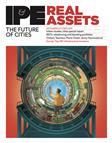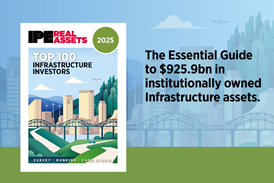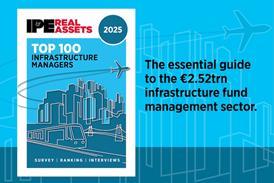AI could revolutionise the industry, leading to either consolidation, as incumbents race toward becoming trillion-dollar managers, or disruption, as nimble, AI-native firms displace legacy structures, writes Faisal Butt
The rate of AI adoption amongst real estate investment managers is accelerating in spite of today’s current market uncertainties. Even at this early stage of integration, the benefits of adoption are clear, both in terms of data-driven decision-making and accelerated business performance.

A new report from Pi Labs, an investor in AI in real estate, reveals how AI is reshaping both pre-deal and post-deal workflows. The findings show that AI is beginning to transform real estate investment management and is impacting each link in the REIM value chain.
In compiling the report, the team conducted six interviews with leading investment managers, interviewed a Swiss-based AI proptech, as well as undertook a natural language analysis of 1,428 AI proptech company descriptions and anonymised portfolio data.
The headline finding is that the cumulative effect is profound, with AI having the potential to drive profitability ratios from 55.2% today to 71.5% by 2030.
Today, AI is already compressing timeframes, reducing error-prone manual work and opening new strategic opportunities - allowing real estate executives to allocate their time to higher-value initiatives.
At pre-deal stage, AI is fundamentally transforming the process from fragmented and manual, to integrated, data-driven, and decision-ready. AI is garnering data from the research, deal sourcing and due diligence stages, taking reports from 50 different places, to create one synthesised decision-ready view. This has been found to reduce workloads by up to 90%.
Lease abstraction and document review - which has traditionally taken weeks by analysts - is now automated, with 80-90% accuracy. Meanwhile, AI sourcing platforms are expanding pipelines and applying predictive scoring.
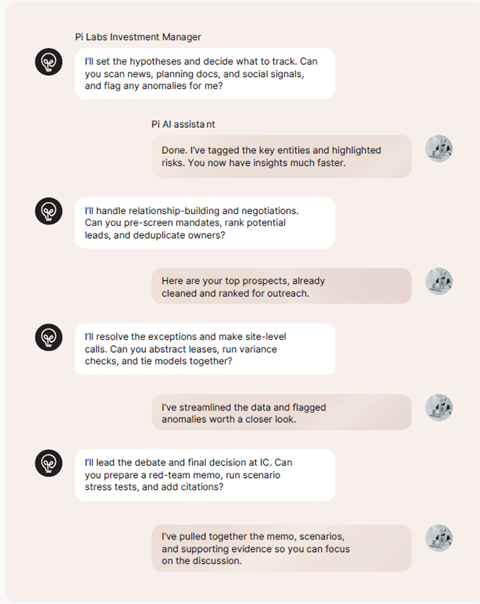
At post-deal stage, the use cases includes predictive modelling of tenant churn, dynamic rent optimisation and energy-use analytics, all of which are influencing asset performance.
Swiss-based AI proptech Optiml has outlined how it is possible to reduce asset management expenditure by 30-50%.
This is achieved by processing high-dimensional datasets such as building conditions, emissions, heating infrastructure, climate forecasts, subsidies, regulatory trajectories and stakeholder constraints and merging them with forward-looking, investment-grade insights.
Separately, in capital raising, case studies suggest AI can reduce LP response times from two weeks to two hours, improving engagement scores by 67% and accelerating overall fundraising cycles.
According to Pi Labs’ analysis of AI use cases in real estate, using the Bessemer Venture Partners’ scale as a framework for mapping agent autonomy, most current applications remain at the co-pilot stage (AI assisting workflows).
However, the trajectory indicates a shift toward Agentic AI, where systems progress from support roles to autonomous task execution and ultimately, decision-making.
Pi Labs have produced a future organisation chart demonstrating how company structures will evolve with the advent of AI.
This outlines the tasks that the VC predicts will be automated by AI and at the other end of the scale, highlights where human input will continue to be the most valuable.
It predicts that AI will be able to lead on deal orientation and compliance, with humans continuing to focus more on relationship building and strategy setting. A hybrid approach will remain best in capital raising and investor relations.
The report’s findings show that employees will be able to double their efficiency with the use of AI tools. One outcome from this is that this will free up their time to dedicate towards higher value/higher impact projects which will create higher return. This will lead to efficiency and profit gains and ultimately less headcount needed to manage a higher AUM.
Looking to the future, the big question is, who will build the best AI-human collaboration model in order to take advantage of the efficiency gains AI has to offer?
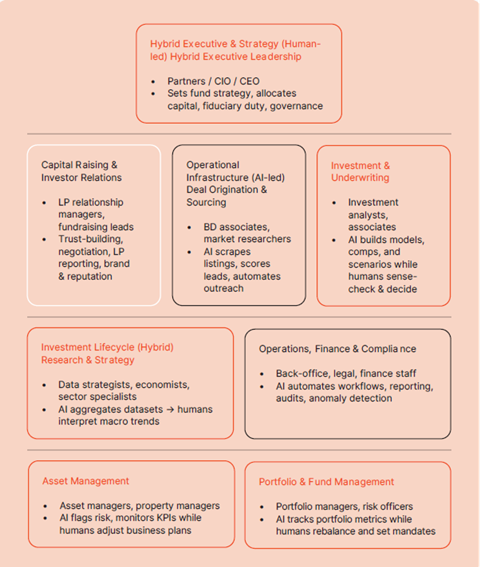
The performance of these AI native companies should outperform predecessors (in terms of relative growth) and this is something that can be observed from analysing Pi Labs’ own startup portfolio, where AI-native companies achieved revenue expansion approximately five times greater, on a year-on-year basis, than non-AI portfolio companies.
Another big incentive is to look at what investment managers will be able to do with the efficiency gains and 30-50% costs savings brought about by AI-driven real estate investment management.
One path might be to scale and take on more deals, expanding AUM at a faster rate and accelerate growth trajectories, towards £10bn AUM or higher.
Another option might be to improve margin, reducing fees while preserving profitability, sharpening competitive positioning with investors. A final option to highlight is to focus on returns, redirecting analyst capacity toward value-creation activities, such as optimising tenant mix or change-of-use strategies.
Ultimately, whilst AI is not yet a substitute for human judgement and execution, it is already an amplifier of managerial capacity, with clear signs of huge future potential. Widespread adoption could trigger an upheaval in the industry league tables. Investment managers that embed AI across the value chain may race ahead.
There are two potential outcomes as a result. The first is consolidation, where the largest incumbents harness AI to scale even faster, potentially creating the first trillion-dollar real estate investment manager as they concentrate capital and talent. The other is disruption, where nimble AI-native challengers exploit their lean cost base to outcompete incumbents that are burdened by legacy structures.
What is clear is that the next reshuffle of industry leadership will likely be driven not be geography or asset class, but by the speed and depth with which firms embrace AI.
To read the latest IPE Real Assets magazine click here.

